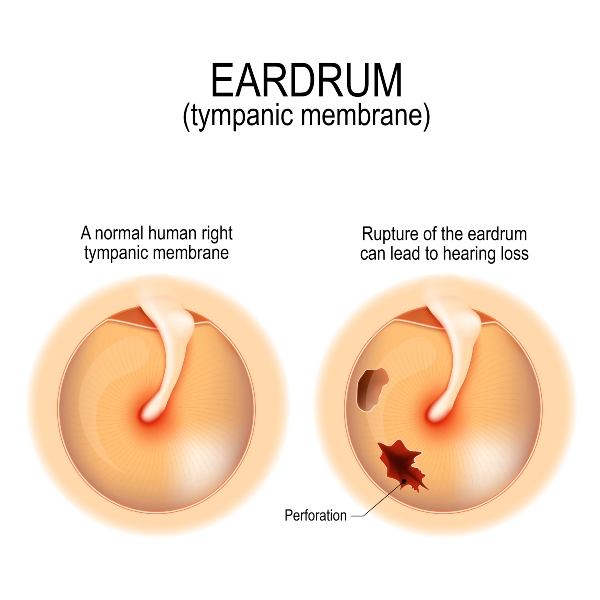Ruptured Eardrum
We’ll Treat Your Ruptured Eardrum in Colorado
A ruptured eardrum can be scary and painful. This common ear injury affects thousands of people each year, but proper care makes recovery possible. Castle Rock Ear Associates specializes in treating ear injuries and hearing problems in Douglas County, CO. Our experienced otolaryngologists use the latest diagnostic tools and treatment methods to help patients recover quickly and safely. This guide covers everything you should know about ruptured eardrums, their symptoms, and treatment options.

What Is a Ruptured Eardrum?
A ruptured eardrum is a tear or hole in the thin tissue that separates your ear canal from your middle ear. This tissue is called the tympanic membrane or eardrum.
The eardrum plays two critical roles. First, it vibrates when sound waves hit it, helping you hear. Second, it protects your middle ear from bacteria, water, and other foreign substances. When the eardrum tears, it can’t do these jobs properly. As a result, ruptured eardrums can lead to hearing loss and increase the risk of ear infections.
Understanding Ruptured Eardrum Symptoms
Ruptured eardrum symptoms vary from person to person. Some people feel severe pain, while others may not notice any discomfort. For those with pain, it often starts suddenly and may feel like sharp stabs. However, it usually decreases quickly once the eardrum ruptures and pressure releases. Other common eardrum rupture signs include:
- Clear, pus-filled, or bloody discharge from the ear
- Hearing loss in the affected ear
- Ringing in the ear, or tinnitus
- A spinning sensation, or vertigo
- Nausea from vertigo
- Facial weakness on the affected side
What Causes a Ruptured Eardrum?
Several factors can lead to a perforated eardrum. Understanding these causes can help you prevent this injury.
- Ear Infections – Middle ear infections are the most common cause of ruptured eardrums. When fluid builds up behind the eardrum, it creates pressure. If the pressure becomes too great, the eardrum can tear.
- Sudden Pressure Changes – Quick changes in air pressure can damage your eardrum. This might happen when you’re flying, scuba diving, or driving in the mountains.
- Direct Injury – Poking your ear with cotton swabs, hairpins, or other objects can puncture the eardrum. Even cleaning your ears too aggressively can cause damage.
- Loud Noises – Very loud sounds, like explosions or gunshots, can rupture eardrums. This type of injury is called acoustic trauma.
- Head Trauma – Severe head injuries, like those from car accidents or sports, can damage the eardrum.
When to See an Otolaryngologist
You should see an ear specialist if you have any ruptured eardrum symptoms. Getting prompt medical care is essential for proper healing and preventing complications. Seek immediate medical attention if you experience:
- Severe pain that doesn’t improve
- Discharge from your ear that lasts more than 24 hours
- Hearing loss
- Signs of infection, such as fever or increased pain
- Dizziness that doesn’t go away
How We Diagnose Perforated Eardrums
Our otolaryngologists will examine your ear using a special tool called an otoscope. This instrument has a light that allows the doctor to see inside your ear canal and look at your eardrum. During the exam, our doctors will look for tears or holes in the eardrum, signs of infection, fluid buildup, or other damage to the ear. Sometimes, the following additional tests may be necessary:
- Hearing tests to check how much hearing loss has occurred
- Tympanometry to measure how well the eardrum moves
- CT scans if there are signs of serious injury
Treating a Ruptured Eardrum
Most ruptured eardrums heal within a few weeks. However, proper care is essential for safe healing and preventing infection.
At-Home Care
- Keep your ear dry
- Take over-the-counter pain medicine as needed
- Don’t use ear drops unless prescribed by your doctor
Medical Treatment
Your doctor may prescribe:
- Antibiotic ear drops to prevent infection
- Oral antibiotics if an infection is present
- Pain medication for severe discomfort
Surgical Options
The most common surgery is called tympanoplasty. During this procedure, a surgeon will use a small piece of tissue to patch the hole. Surgery may be needed if:
- The eardrum doesn’t heal after two months
- Hearing loss continues
- Chronic infections develop
Tips to Prevent a Ruptured Eardrum
You can take these steps to protect your eardrums from injury:
- Treat ear infections promptly
- Never put objects in your ears
- Wear ear protection around loud noises
- Blow your nose gently, one nostril at a time
- Stay up-to-date on vaccinations to prevent infections
- See a doctor for persistent ear pain or discharge
FAQ About Ruptured Eardrums
Here are some of the most frequently asked questions about ruptured eardrums and their answers:
Sleep with the affected ear facing up. This position helps drainage and reduces pressure on the injured eardrum. Use extra pillows to keep your head elevated. Most people recover completely within six to eight weeks. You may experience hearing loss and discharge during healing. Pain usually improves within a few days. Keep your ears dry and clean and avoid inserting anything into your ear canal. Furthermore, get prompt treatment for ear infections and protect your ears from loud noises.
Contact Our Team in Castle Rock Today
If you suspect you have a ruptured eardrum, don’t wait for treatment. Castle Rock Ear Associates provides expert care for all types of ear injuries and conditions at our clinic in Castle Rock, CO. Contact us today to schedule an appointment so that we can customize a treatment plan for you.
